- Kioti Tractor Dashboard Symbols Meaning
- All Kioti Instrument Cluster Symbols & Lights
- General Dash Symbols
- Body-related Dash Symbols
- Engine-related Dash Symbols
- Electric-related Dash Symbols
- Hydraulic-related Dash Symbols
- PTO-related Dash Symbols
- Attachment-related Dash Symbols
- SSL / CTL Loader Dash Symbols
- Colors of Kioti Tractor Warning Lights
- How to Reset Kioti Warning Lights
Operating Kioti tractors, loaders, UTVs, and zero-turn mowers efficiently and safely requires a good understanding of the dashboard warning lights, symbols, indicators, and gauges. These instruments are designed to provide real-time feedback about the machine’s performance and condition, ensuring that operators can address any issues promptly and maintain optimal functionality. Understanding the dashboard symbols, indicators, warning lights, and gauges in Kioti equipment is crucial for proper operation and maintenance.
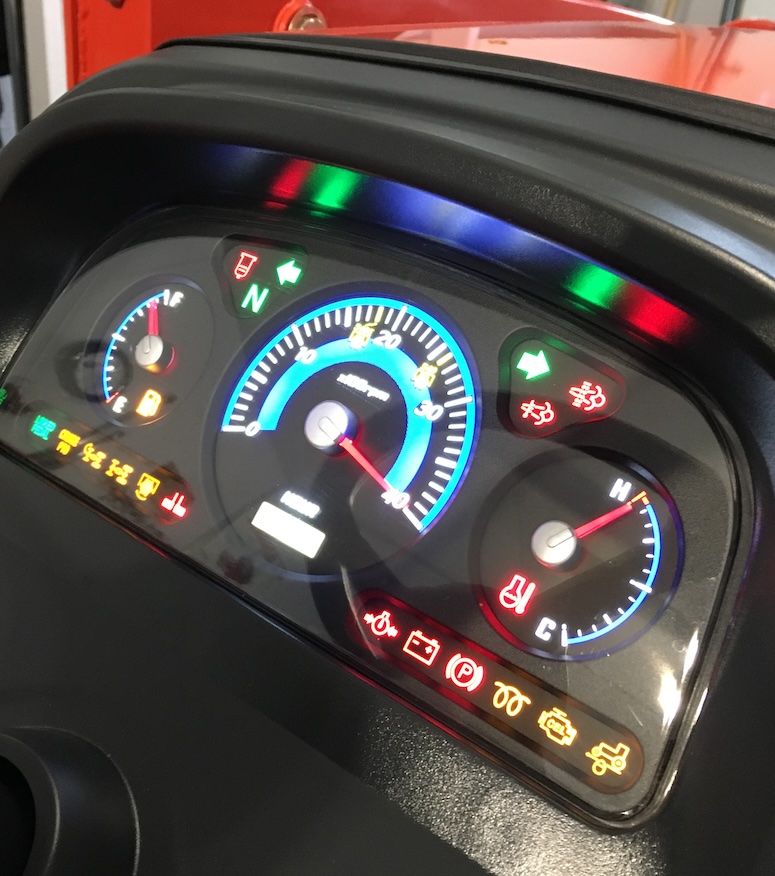
Always refer to the Kioti operator’s manual for detailed explanations and specific instructions related to your model. Regular checks and maintenance are crucial to ensure that all systems function correctly and to avoid unexpected breakdowns. If any warning lights remain on or gauges indicate abnormal readings, seek professional assistance to diagnose and fix the issue promptly. This guide serves as a comprehensive reference to help you recognize and interpret the various warning lights, symbols, indicators, and gauges on your Kioti equipment (tractors, lawn mowers, UTVs & compact loaders).
Kioti Tractor Dashboard Symbols Meaning
The instrument cluster on a Kioti tractor is designed to provide the operator with essential information about the machine’s status and performance. These symbols and indicators help monitor the tractor’s operation and alert the operator to any issues that need attention. Below, we provide a sample of common symbols you might encounter on a Kioti tractor’s instrument cluster, along with their meanings:
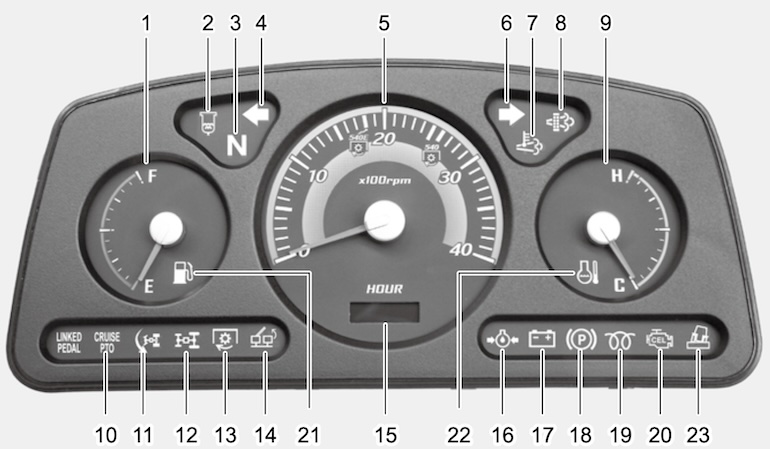
- Fuel Gauge – Displays the amount of fuel in the tank. Ensure to keep an eye on this gauge to avoid running out of fuel during operation.
- Water-in-Fuel Warning Lamp – Indicates the presence of water in the fuel filter. Water contamination can cause engine damage, so it is important to drain the water separator.
- Neutral Indicator – Shows that the transmission is in neutral. This is crucial for starting the engine and for safe operation.
- Turn Signal Lamp (LH) – Indicates the left turn signal is active. Use this when making left-hand turns to alert other drivers and pedestrians.
- Tachometer – Displays the engine’s RPM (revolutions per minute). Helps in monitoring engine performance and avoiding over-revving.
- Turn Signal Lamp (RH) – Indicates the right turn signal is active. Use this when making right-hand turns.
- DPF Regeneration Underway Lamp – means that the Diesel Particulate Filter (DPF) regeneration process is in progress. Continue operating to complete the cycle.
- DPF Regeneration Warning Lamp – Alerts you to issues with the DPF system. Immediate attention may be required to avoid engine damage.
- Coolant Temperature Gauge – Monitors the engine coolant temperature. High readings indicate the engine is overheating and needs immediate attention.
- Cruise PTO Warning Lamp – Indicates an issue with the Cruise Power Take-Off (PTO) system. Check the system before continuing operation.
- Quick-Turn Indicator (if applicable) – Indicates the quick-turn system is active. This system helps in making sharper turns with less steering effort.
- 4WD Indicator – Shows that the four-wheel drive (4WD) system is engaged. Use 4WD for better traction in rough or slippery conditions.
- PTO Indicator – Indicates that the Power Take-Off (PTO) is engaged. Ensure the PTO is disengaged before starting the engine or when it is not in use.
- Single Brake Light – Indicates that one of the brake pedals is pressed. Ensure both brakes are applied evenly for safe stopping.
- Hourmeter + Error Indicator – Records the total operating hours of the tractor. You can see the Kioti error code below on the lcd for hourmeter. when you found these on the display, please contact with official dealer.
- Engine Oil Pressure Warning Lamp – Indicates low engine oil pressure. Stop the engine immediately and check oil levels to prevent damage.
- Low Battery Charge Warning Lamp – Alerts you to a low battery charge. Ensure the alternator and charging system are functioning properly.
- Parking Brake Indicator – Shows that the parking brake is engaged. Always release the parking brake before moving the tractor.
- Glow Plug Indicator – Indicates the glow plugs are active and heating up the engine cylinders for starting. Wait for the light to go out before starting a diesel engine in cold conditions.
- Engine Check Lamp – Alerts you to a general engine issue. Diagnostics are required to determine the exact problem.
- Lack of Engine Warning Light – Indicates a severe engine malfunction. Stop the tractor immediately and seek professional assistance.
- Coolant Temperature Warning Light – Indicates the engine coolant temperature is too high. Stop the engine and allow it to cool down before continuing.
- Auto Balance Lamp (if equipped) – Shows that the auto balance system is active. This system helps maintain stability on uneven terrain.
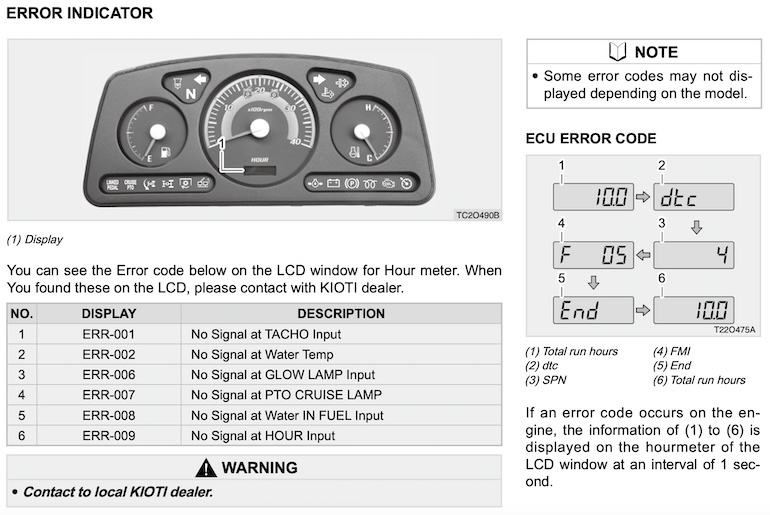
By familiarizing yourself with these and other symbols on your Kioti tractor’s instrument cluster, you can ensure timely maintenance and avoid potential issues, keeping your tractor running smoothly and efficiently!
All Kioti Instrument Cluster Symbols & Lights
Understanding these signals is crucial for preventive maintenance, troubleshooting, and ensuring the longevity and reliability of your machinery. Whether you’re a new operator or an experienced user, this guide will enhance your ability to manage your Kioti equipment with confidence and precision.
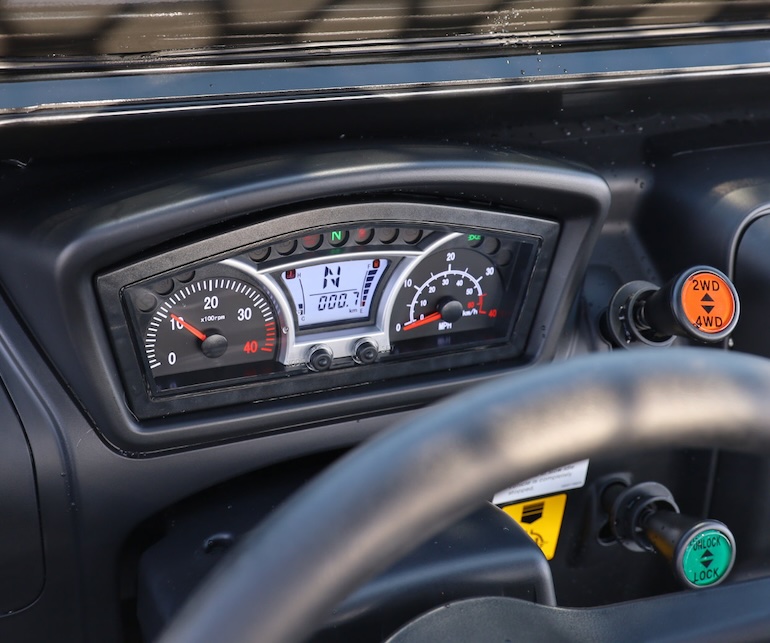
General Dash Symbols
| Symbol | Name | Description |
|---|---|---|
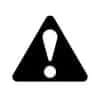 |
Safety Alert Symbol | Indicates a safety alert or warning. |
 |
Stop | Indicates a serious tractor malfunction in the tractor’s systems that requires immediate attention. |
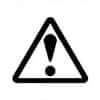 |
Master System Warning | Alerts about a critical issue with the tractor’s master system. |
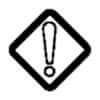 |
Service Alert | Illuminates when a malfunction occurs (review error code in Information Display). |
 |
Setup / Settings | System Setup / Settings. |
 |
Read Operator’s Manual | Indicates the need to consult the operator’s manual for information. |
 |
Malfunction! (Alternative) | See operator’s manual. |
 |
Fast | Indicates a high-speed setting or mode. |
 |
Slow | Indicates a low-speed setting or mode. |
 |
Creep | Indicates engagement of the tractor’s super creep gear, which provides exceptionally slow speeds for specific applications. |
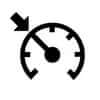 |
Cruise Control | Indicates that cruise control is engaged. Maintains a constant speed set by the operator. |
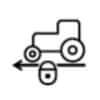 |
Tractor Cruise Control | Indicates that the cruise control feature is activated, maintaining a set speed without manual throttle control. |
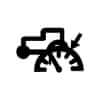 |
Speed Limit Switch | Indicates that the speed limit feature is activated, restricting the tractor’s maximum speed. |
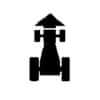 |
Ground Speed | Displays the current ground speed of the tractor, allowing for precise control. |
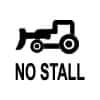 |
No Stall | Indicates an anti-stall feature is active, preventing the engine from stalling during heavy loads. |
 |
Limp Home | Activates a reduced power mode for emergency situations. |
 |
Lock | Indicates that a function or system is locked or engaged. |
 |
Unlock | Indicates that a function or system is unlocked. |
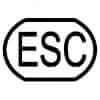 |
Escape | Allows exiting a menu or mode. |
 |
ECO Mode | Indicates that the equipment is operating in economy mode, optimizing fuel efficiency. |
 |
ON (Engaged) | Indicates that a system or function is active or engaged. |
 |
OFF (Disengaged) | Indicates that a system or function is inactive or disengaged. |
 |
Transmission Neutral Indicator | indicates that the tractor is in neutral gear. This light signifies that the transmission is in a neutral position, meaning the tractor is not engaged in any forward or reverse movement. |
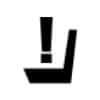 |
Operator Presence Sensor (OPS) | Illuminates when the tractor operator’s seat is unoccupied, reminding the operator to sit properly for safe operation. |
 |
Operator Presence Sensor (Alternative) | Illuminates when the tractor operator’s seat is unoccupied. |
 |
Operator Presence Control (Alternative) | This safety feature ensures that the tractor or equipment will not operate unless there is sufficient weight on the seat to indicate the presence of an operator. |
 |
Seat Belt Control | Seat belt control lamp / indicator. |
 |
Message | Vehicle messages button. |
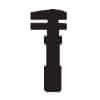 |
Service Mode | Service mode selected. |
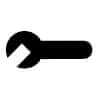 |
Service | Indicates that the tractor requires servicing or maintenance. |
 |
Information | This switch is used to control the display of information on the instrument cluster, such as engine hours, fuel level, and other operational data. The specific meaning of the symbol may vary depending on the model of the equipment. |
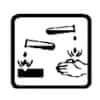 |
Warning! Corrosive Substance | Indicates the presence of a corrosive substance. Use caution when handling. |
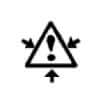 |
Pressurised Open Carefully | Warns to open a pressurized component carefully to avoid injury. |
 |
Hazard Warning Lights | Activates the hazard lights to warn others of potential danger. |
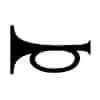 |
Audible Warning Device | Indicates the status of the audible warning device. |
Body-related Dash Symbols
| Symbol | Name | Description |
|---|---|---|
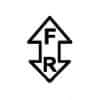 |
Travel Direction | Indicates the current direction of tractor travel. |
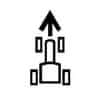 |
Travel Direction Forward | Indicates forward travel direction. |
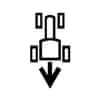 |
Travel Direction Rearward | Indicates reverse travel direction. |
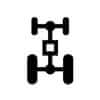 |
4-Wheel Drive On | Indicates engagement of the tractor’s four-wheel-drive (4WD) system with differential lock, providing increased traction in challenging terrain. |
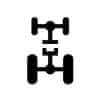 |
4-Wheel Drive Off | Indicates that the tractor’s 4-wheel drive system is disengaged. |
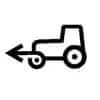 |
Four-wheel On | Engages the four-wheel drive system. |
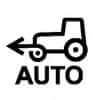 |
Four-wheel Automatic | Automatically adjusts the four-wheel drive system based on conditions. |
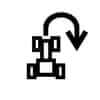 |
Headland Management System | Manages tractor operations during headland turns. |
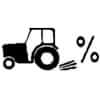 |
% Age Slip | Displays the percentage of slippage in the transmission or drive system. |
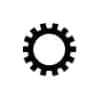 |
Transmission Service Required | Transmission service required. |
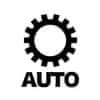 |
Auto Transmission | Engages automatic transmission mode. |
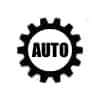 |
Auto Transmission (Alternative) | Engages automatic transmission mode. |
 |
Auto Transmission Sensitivity | Adjusts the sensitivity of the automatic transmission. |
 |
Auto Transmission Road Control | Optimizes transmission settings for road conditions. |
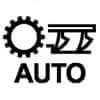 |
Auto Transmission Field Control | Optimizes transmission settings for field conditions. |
 |
Transmission Oil Filter | Indicates a restricted or clogged transmission oil filter, which can impede hydraulic function and transmission performance. |
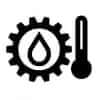 |
Transmission Oil Temperature | Warns the operator when the transmission oil temperature exceeds safe operating levels, indicating potential overheating or insufficient cooling. |
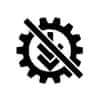 |
Gear Shifting Warning | Indicates a problem with gear shifting. |
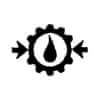 |
Transmission Oil Pressure | Warns of low transmission oil pressure, which could affect transmission performance. |
 |
Rear Axle Oil Temperature | Indicates the temperature of the oil in the rear axle, ensuring it remains within safe operating limits. |
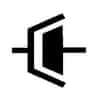 |
Clutch | Engages or disengages the tractor clutch. |
 |
High Range | Indicates that the tractor is in high gear range, suitable for higher speed operations. |
 |
Mid Range | Shows the transmission is in medium gear range. |
 |
Low Range | Indicates that the tractor is in low gear range, suitable for lower speed operations requiring more power. |
 |
High Speed Travel | Indicates that the tractor is operating in high speed travel mode. |
 |
Mid Speed Travel | Shows the tractor is operating at medium speed. |
 |
Low Speed Travel | Signals the tractor is in low-speed mode. |
 |
Transmission Oil Filter | Warns of an issue with the transmission oil filter, such as needing replacement or cleaning. |
 |
Brake | Alerts the operator to low brake fluid levels in the tractor’s brake system, indicating potential brake failure or leakage. |
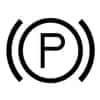 |
Parking Brake | Engages the tractor parking brake. Illuminates when the handbrake or parking brake is engaged, reminding the operator to disengage it before driving. |
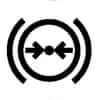 |
Air Brake | Indicates the status of the air brake system. |
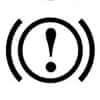 |
Brake Failure / Malfunction | Alerts about brake system failure or malfunction. |
 |
Trailer Brake | Indicates the status of the trailer brake system, ensuring safe towing operations. |
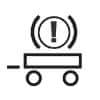 |
Trailer Brake (Alternative) | This light will come on when the trailer brakes are active. |
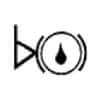 |
Brake Fluid Level | Warns that the brake fluid level is low, which may affect braking performance. |
 |
Stop Lamps | Indicates that the stop lamps are activated, alerting others that the tractor is stopping. |
 |
Differential Lock | Indicates engagement of the tractor’s differential lock, enhancing traction in slippery or uneven terrain. |
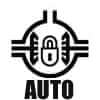 |
Differential Lock Automatic | Automatically engages the differential lock based on conditions. |
 |
Differential Lock (Alternative) | Indicates that the differential lock is engaged, providing equal power to both wheels on an axle. |
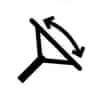 |
Steering Wheel Tilt | Adjusts the tilt angle of the steering wheel. |
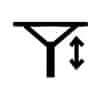 |
Steering Wheel Telescope | Adjusts the telescoping position of the steering wheel. |
 |
Automatic Steering Control | Engages automatic steering control. |
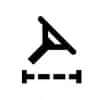 |
Steering Oil Filter | Indicates the status of the steering oil filter. |
 |
Front Suspension | Indicates the status of the front suspension system. |
 |
Front Suspension Automatic | Automatically adjusts the front suspension based on conditions. |
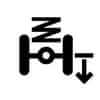 |
Front Suspension Down | Lowers the front suspension. |
 |
Front Suspension Up | Raises the front suspension. |
 |
Front Suspension Lock | Locks the front suspension in position. |
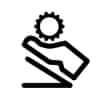 |
Twin Touch Foot Controls | The symbol which provide quick and easy forward/reverse operation. |
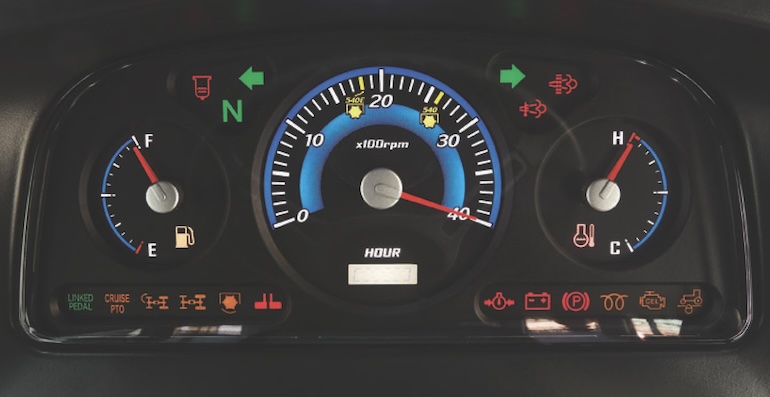
Engine-related Dash Symbols
| Symbol | Name | Description |
|---|---|---|
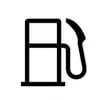 |
Fuel Level | Indicates the level of fuel in the tank. |
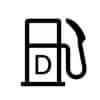 |
Diesel Fuel | Indicates the level of diesel fuel in the tank. |
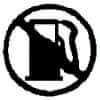 |
Automatic Fuel Shut-off | Signals that the automatic fuel shut-off system is active, preventing fuel flow. |
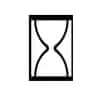 |
Hourmeter / Elapsed Operating Hours | Displays the total operating hours or elapsed time. |
 |
Engine Temperature / Coolant Temperature | Warns the operator when the engine coolant temperature exceeds safe operating limits, indicating potential overheating. |
 |
Low Coolant Level | Warns that the engine coolant level is low and needs to be refilled. |
 |
Engine Coolant Temperature | Engine coolant temperature warning light. |
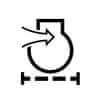 |
Engine Intake / Combustion Air Filter | Indicates the condition of the engine air filter. Warns the operator when the air filter becomes clogged or restricted, reducing airflow to the engine and affecting performance. |
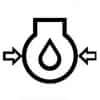 |
Engine Oil Pressure | Indicates the oil pressure in the engine. Warns the operator when engine oil pressure drops below a safe level, indicating potential engine damage or oil system malfunction. |
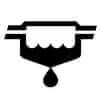 |
Water Separator | Indicates the status of the water separator in the fuel system. |
 |
Water in Fuel Warning | Indicates that there is water in the diesel fuel. This can be a serious issue, as water in diesel fuel can cause damage to the engine and fuel system. |
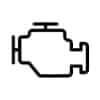 |
Engine Alert | Indicates various functions and warnings related to the engine and its operation (Engine Check). |
 |
Engine Emissions Warning / Malfunction | It typically indicates an emissions-related issue, such as a problem with the exhaust aftertreatment system, DPF (Diesel Particulate Filter), EGR (Exhaust Gas Recirculation), or SCR (Selective Catalytic Reduction) system. |
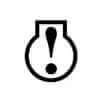 |
Engine Warning | Indicates the presence of a fault code or error condition in the engine control system, prompting the operator to address the issue promptly. |
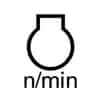 |
Engine Rotational Speed | Displays the rotational speed of the engine. |
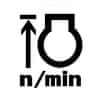 |
Engine Rotational Speed, Maximum | Limits the maximum engine speed to prevent damage. |
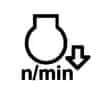 |
Engine Rotational Speed, Instantaneous Decrease | Alerts when the engine exceeds its maximum safe speed. |
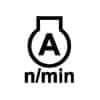 |
Engine RPM Memory A | Stores and recalls a specific engine RPM setting. |
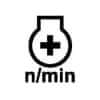 |
Engine RPM Adjuster | Allows adjustment of the engine RPM. |
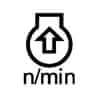 |
Engine Rotational Speed, Instantaneous Increase | Increases the engine RPM. |
 |
Engine Speed Control | Engine Speed Control. |
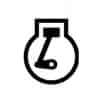 |
Engine Run | Indicates that the engine is running. |
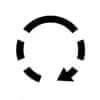 |
Engine Start | Initiates the engine starting process. |
 |
Starter Control | Indicates an issue or status related to the engine’s starting system (Automatic Start Assist / Starter Motor Engaged / Starter System Fault). |
 |
Engine Stop | Stops the engine. |
 |
Engine Heater (Low Temperature Start Aid) | Illuminates when the engine block heater is in operation, helping to warm the engine for easier starting in cold conditions. Diesel Preheat / Glow Plugs. |
 |
Engine Heater (Alternative) | This light may illuminate when the engine heater is in operation to warm up the engine in cold conditions. |
 |
Diesel Preheat (Glow Plugs Activation) | It means the glow plugs are warming up to assist with cold engine starting. |
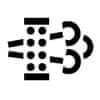 |
Regeneration | Initiates the regeneration process for the diesel particulate filter. |
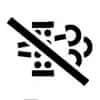 |
Regeneration Inhibit | Prevents regeneration from occurring. |
 |
DEF / AdBlue Trouble | Indicates a problem with the DEF or AdBlue system. |
 |
Regeneration Switch | Activates the regeneration process manually. |
 |
Parked Regeneration | Initiates regeneration while the vehicle is stationary. |
 |
DEF / AdBlue-Level | Indicates the level of Diesel Exhaust Fluid (DEF) or AdBlue. |
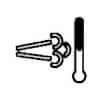 |
High Exhaust Temperature | Indicates that the temperature inside the exhaust filter is high, which may require attention to prevent damage to the exhaust system. |
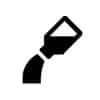 |
DEF / AdBlue Low Level | Alerts when the DEF or AdBlue level is low. |
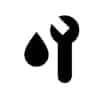 |
DEF / AdBlue Poor Quality | Alerts when the quality of DEF or AdBlue is compromised. |
 |
DEF / AdBlue Freeze | Alerts when DEF or AdBlue is at risk of freezing. |
Electric-related Dash Symbols
| Symbol | Name | Description |
|---|---|---|
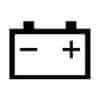 |
Battery Charging Condition | Indicates a malfunction in the tractor’s charging system, typically caused by a faulty alternator or battery, which may result in battery discharge. |
 |
Electrical Power Accessories | Indicates the status of electrical power accessories. |
 |
Master Lighting Switch | Controls the master lighting system. |
 |
Headlight Low Beam | Activates low beam headlights. |
 |
Headlight High Beam | Illuminates the tractor’s headlights for visibility in low-light conditions or during nighttime operation. |
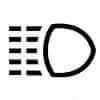 |
Headlight Flashing | Activates the headlight flash function. |
 |
Work Light | Activates tractor work lights. |
 |
Position Lamps | Controls position lamps. |
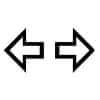 |
Turn Signal | Indicates tractor turn signals. |
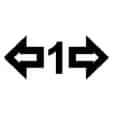 |
Turn Signal 1 Trailer | Indicates turn signals for #1 trailer. |
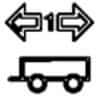 |
Trailer 1 Turn Signal Indicator | Indicates turn signals for #1 trailer. |
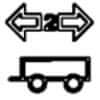 |
Trailer 2 Turn Signal Indicator | Indicates turn signals for #2 trailer. |
| Beacon Light | Controls beacon lights. | |
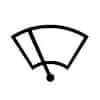 |
Windshield Wiper | Activates windshield wipers. |
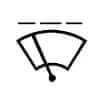 |
Windshield Wiper Intermittent | Activates intermittent windshield wiper function. |
 |
Windshield Washer | Activates windshield washer. |
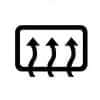 |
Rear Window Defroster | Activates rear window defroster. |
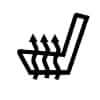 |
Seat Heater Switch | Use switch to turn seat heater ON or OFF. |
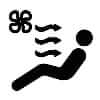 |
Air Flow Direction | Air flow direction switch / indicator. |
 |
Air Conditioner Indicator | Activates air conditioner. |
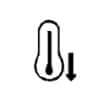 |
Air Conditioner | It indicates that the air conditioning system is active and cooling the cabin. |
 |
Heater Fan | Indicates that the heater fan is operational, providing ventilation or warmth to the cab. |
Hydraulic-related Dash Symbols
| Symbol | Name | Description |
|---|---|---|
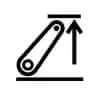 |
Lift Arm Control Up / Transport | Raises or lowers lift arms for transport mode. |
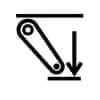 |
Lift Arm Control Down | Lowers tractor lift arms. |
 |
Lift Arm Control Upward | Raises tractor lift arms. |
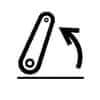 |
3-Point Lifting / Lowering | Controls the three-point hitch for lifting or lowering implements. |
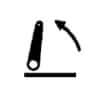 |
3-Point Lifting (Alternative) | Controls the 3-point hitch for lifting implements. |
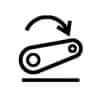 |
Lift Arm Control Downward | Lowers lift arms. |
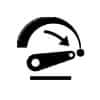 |
Position Control – Lowering | Indicates the position control lever is in the lowering position for the implement. |
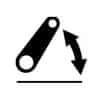 |
Lift Arm Height | Indicates the height of the lift arms. |
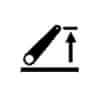 |
Hitch Height Limit (Rear) | Indicates the rear hitch height limit setting. |
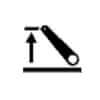 |
Hitch Height Limit (Front) | Indicates the front hitch height limit setting. |
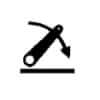 |
Hitch Lower (Rear) | Lowers the rear hitch. |
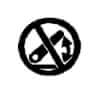 |
Hitch Disabled | Alerts that the tractor’s hitch system is disabled, preventing attachment movements. |
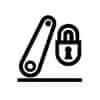 |
Lift Arm Control Lock | Locks tractor lift arm controls. |
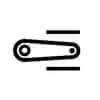 |
Lift Arm Control Block | Locks lift arms in position. |
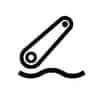 |
Lift Arm Control Float | Allows tractor lift arms to float. |
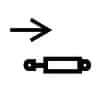 |
Remote Cylinder Retract | Retracts remote hydraulic cylinders. |
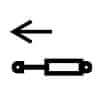 |
Remote Cylinder Extend | Extends remote hydraulic cylinders. |
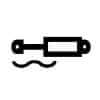 |
Remote Cylinder Float | Allows remote hydraulic cylinders to float. |
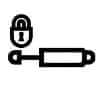 |
Remote Cylinder Lock A | Locks remote hydraulic cylinder control. |
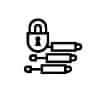 |
Remote Cylinder Lock B | Locks remote tractor hydraulic cylinder control. |
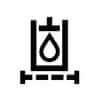 |
Hydraulic Oil Filter | Indicates the status of the hydraulic oil filter. |
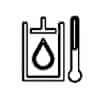 |
Hydraulic Oil Temperature | This warning light may illuminate if the hydraulic oil is overheating, signaling a potential issue with the hydraulic system. |
 |
Hydraulic Oil Temperature (Alternative) | Hydraulic oil temperature warning light. |
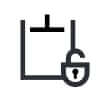 |
Hydraulic Lock Device | Indicates that the hydraulic lock device is engaged, preventing unintended hydraulic movements. |
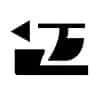 |
Draft Control | Manages the draft control system for implements. |
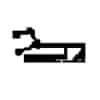 |
Draft Control (Alternative) | Shows the status of the draft control system, which adjusts the implement depth based on soil resistance. |
 |
Automatic Draft Operation | Indicates that the automatic draft control system is active, maintaining consistent soil penetration. |
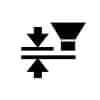 |
Position Control | Controls the height or position of attached implements. |
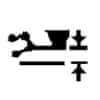 |
Position Control (Alternative) | Indicates the position control function, which maintains a set height for the tractor’s implement. |
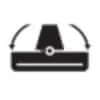 |
Automatic Horizontal Operation | Indicates that the automatic horizontal control system is active, keeping implements level. |
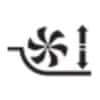 |
Automatic Tilling Depth Operation | Indicates that the automatic tilling depth control is active. |
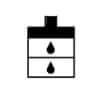 |
Hydraulic / Transmission Filters | Warns of potential issues with the hydraulic or transmission filters, indicating a need for service or replacement. |
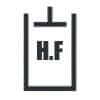 |
High Flow Indicator | Indicates that the hydraulic system is operating in high flow mode. |
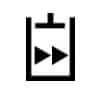 |
High Flow (Alternative) | Indicates high hydraulic flow is active. |
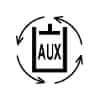 |
AUX Hold | Represents auxiliary hydraulic function hold. |
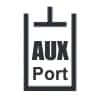 |
Auxiliary Hydraulic Port | Shows the status of auxiliary hydraulic ports. |
 |
AUX Electric Port | Shows the status of the auxiliary electric port. |
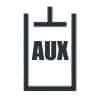 |
Auxiliary Operation Indicator | Indicates that an auxiliary function is active. |
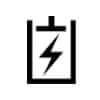 |
AUX Electric Port indicator | Indicates that the auxiliary electric port is active. |
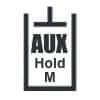 |
AUX Hydraulic Port Hold M/F | Indicates the auxiliary hydraulic port hold mode/function is active. |
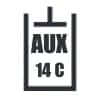 |
AUX 14-Pin C Symbol | Shows the status of the 14-pin auxiliary electrical connector. |
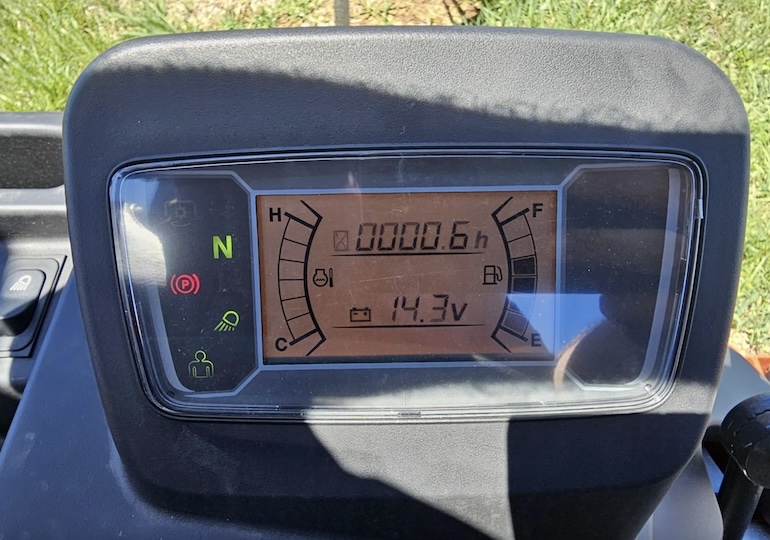
PTO-related Dash Symbols
| Symbol | Name | Description |
|---|---|---|
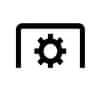 |
PTO Off (Disengaged) | Deactivates the power take-off. |
 |
PTO On (Engaged) | Activates the power take-off. |
 |
PTO F Front | Indicates the front power take-off is active for front-mounted implements. |
 |
PTO R Rear | Indicates the rear power take-off is active for front-mounted implements. |
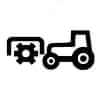 |
PTO Front | Indicates the front power take-off is active for front-mounted implements. |
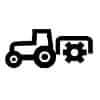 |
PTO Rear | Indicates the rear power take-off is active for front-mounted implements. |
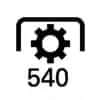 |
PTO 540 rpm | Indicates engagement of the tractor’s power take-off (PTO) system at 540 revolutions per minute. |
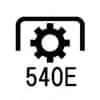 |
PTO 540E rpm | Indicates the power take-off speed of 540E rpm. |
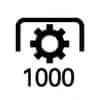 |
PTO 1000 rpm | Indicates engagement of the tractor’s power take-off (PTO) system at 1000 revolutions per minute. |
 |
PTO 1000E rpm | Indicates the power take-off speed of 1000E rpm. |
 |
PTO Cruise | Indicates that the PTO cruise control is active, maintaining a constant Power Take-Off speed. |
Attachment-related Dash Symbols
| Symbol | Name | Description |
|---|---|---|
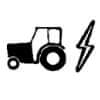 |
Implement Socket | Shows the status of the implement socket, ensuring proper connection and power supply to attached implements. |
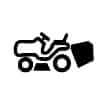 |
Material Collection System | When the symbol is illuminated, it indicates that the material collection system is active or in use. |
 |
Cutting Height | Used for setting the cutting height, possibly for a mower. |
 |
Mower Raised Position | Shows the mower in a raised position. |
 |
Mower Lowered Position | Indicates the mower is in a lowered position. |
 |
Full | Indicates a full level. |
 |
Empty | Indicates an empty level. |

SSL / CTL Loader Dash Symbols
| Symbol | Name | Description |
|---|---|---|
 |
Lift Arm Raise / Bucket Up | Indicates the lift arm is raising or the bucket is being lifted |
 |
Lift Arm Lower / Bucket Down | Indicates the lift arm is lowering or the bucket is being lowered |
 |
Loader Bucket Rollback / Tilt | Indicates the loader bucket is being rolled back or tilted |
 |
Loader Bucket Dump | Indicates the Kubota loader bucket is being dumped |
 |
Loader Bucket Float | Indicates the Kubota loader bucket is in float mode |
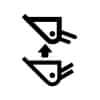 |
Self Leveling Indicator | Indicates that the self-leveling function of the loader is active, keeping the bucket level as the arms are raised or lowered. |
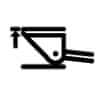 |
Loader Bucket Self Leveling | Indicates the loader bucket is self-leveling. Automatically adjusts the loader bucket to maintain a level position |
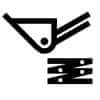 |
Ride Control | Indicates that the ride control feature is active, improving ride comfort by damping loader arm movements. |
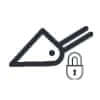 |
Loader Quick Hitch Lock | Indicates the loader quick hitch is locked. Locks the loader bucket or attachment into position quickly |
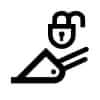 |
Quick Attachment Unlock | Indicates that the quick attachment locking mechanism is disengaged / the quick attachment system is unlocked. |
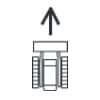 |
Forward (Compact Track Loader) | Indicates the loader is moving forward |
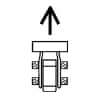 |
Forward (Skid Steer Loader) | Indicates the loader is moving forward |
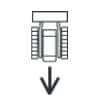 |
Backward (Compact Track Loader) | Indicates the loader is moving backward |
 |
Backward (Skid Steer Loader) | Indicates the loader is moving backward |
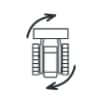 |
Turn Right (Compact Track Loader) | Indicates the machine is turning right |
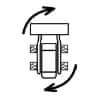 |
Turn Right (Skid Steer Loader) | Indicates the machine is turning right |
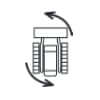 |
Turn Left (Compact Track Loader) | Indicates the machine is turning left |
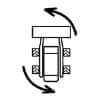 |
Turn Left (Skid Steer Loader) | Indicates the machine is turning left |
 |
Tailgate Safety Cover | Shows the tailgate safety cover is engaged. |
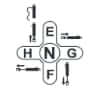 |
Loader Joystick Handle | Indicates the status or position of the loader joystick handle. |
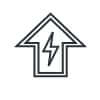 |
AUX Electrical Mode Change | Allows the operator to change the electrical mode for auxiliary functions, enabling the use of specific electrical features or attachments on the tractor or excavator |
Kioti is the trade name for Daedong tractors in markets outside of South Korea. Daedong was founded in 1947 and produced its first tractor in Korea in 1968. In 1993, Daedong entered the US market through Daedong-USA and the Kioti tractor brand.
Understanding the dashboard warning symbols on your Kioti tractor is crucial for maintaining its health and ensuring optimal performance. Whether it’s a low fuel alert, engine warning, or a specific system malfunction indicator, knowing what each symbol means can help prevent minor issues from becoming major repairs. Keep this guide handy for quick reference to ensure your tractor operates smoothly and efficiently. This guide covers the dash warning symbols for the following models:
- Kioti CK Series: CK20S, CK25, CK27, CK30, CK35.
- Kioti CK10 Series: CK2510, CK3510, CK4010.
- Kioti CK20 Series: CK2620, CK2620H, CK2620SE, CK3520, CK3520SE, CK4020, CK4020SE, CK2620SEH Cab, CK3520, CK3520H, CK3520SE, CK3520SEH Cab / ROPS, CK4020, CK4020H, CK4020SE, CK4020SEH Cab / ROPS.
- Kioti CS Series: CS2210, CS2220, CS2410, CS2510, CS2520.
- Kioti CX Series: CX2510, CX2510H, CX2510HCB.
- Kioti DK Series: DK35, DK40, DK45, DK50, DK65, DK75, DK80, DK90, DK451, DK501, DK551, DK561, DK751, DK752, DK901, DK902, DK4520, DK5020, DK5520, DK4220SEH ROPS / Cab, DK4720SEH ROPS / Cab, DK5320HSE ROPS / Cab, DK6020HSE ROPS / Cab.
- Kioti DK10 Series: DK4510, DK5010, DK5510.
- Kioti DS Series: DS3510, DS4110, DS4510.
- Kioti EX Series: EX35, EX40, EX45, EX50.
- Kioti HX Series: HX1151, HX1301, HX1401, HX9010.
- Kioti LB Series: LB1914.
- Kioti LK Series: LK2552, LK2554, LK3052, LK3054, LK3504.
- Kioti NS Series: NS4710, NS4710 HST, NS4710C, NS4710C HST, NS5310H, NS6010, NS6010H, NS6010C, NS6010C HST.
- Kioti NX Series: NX4510, NX4510C, NX4510H, NX4510CH, NX5010, NX5010C, NX5010H, NX5010CH, NX5510, NX5510C, NX5510H, NX5510CH, NX6010, NX6010H, NX6010CH.
- Kioti PX Series: PX1053, PX1153, PX9020, PX9530.
- Kioti RX Series: RX6010, RX6620, RX6620C, RX6620P, RX6620PC, RX7320, RX7320C, RX7320P, RX7320PC, RX7320PCC.
Colors of Kioti Tractor Warning Lights
Understanding the color coding of warning lights on Kioti tractors, loaders, UTVs, and zero-turn mowers is essential for promptly addressing potential issues and ensuring safe operation.
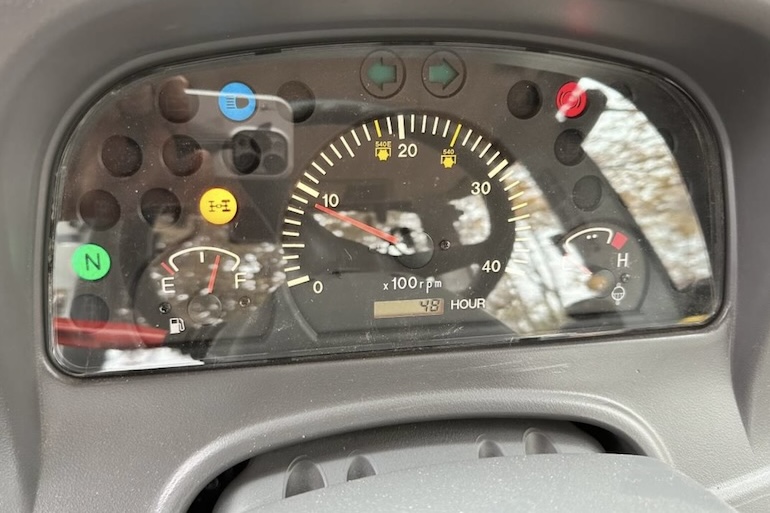
Each color signifies a different level of urgency or type of information:
- Red Warning Lights:
- Indicate Critical Issues: These lights signal severe problems that require immediate attention to prevent damage or ensure safety.
- Examples: Engine overheating, oil pressure low, brake system fault.
- Amber/Yellow Warning Lights:
- Indicate Caution: These lights warn of potential issues that should be checked and resolved soon but are not immediately critical.
- Examples: Low fuel, transmission issues, hydraulic system warnings.
- Green Indicator Lights:
- Indicate Normal Operation: These lights typically show that a system or function is active and operating as expected.
- Examples: Lights on, PTO engaged, differential lock engaged.
- Blue Indicator Lights:
- Indicate Specific Functions: These lights are often used to denote the operation of auxiliary systems or features.
- Examples: High beam headlights, auxiliary power operation.
White indicator lights provide general information about the Kioti machine’s status (examples: neutral gear indicator, seat belt reminder). By familiarizing yourself with these color codes, you can better understand the immediate needs of your Kioti equipment and take appropriate action to maintain safe and efficient operation.
How to Reset Kioti Warning Lights
Resetting warning lights on Kioti tractors, loaders, UTVs, and zero-turn mowers often involves a few straightforward steps. However, it’s essential to ensure that any underlying issues triggering the warning lights are resolved before attempting a reset.
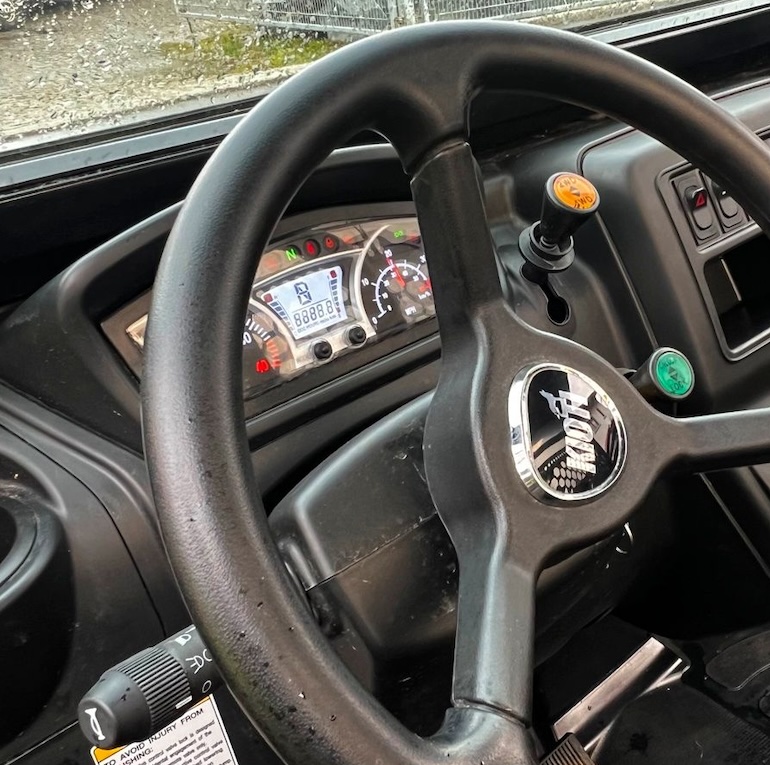
Here’s a basic guide on how to reset Kioti warning lights:
- Consult the Owner’s Manual: Refer to the specific instructions in your Kioti equipment’s owner’s manual. The manual will provide model-specific procedures for resetting warning lights.
- Address Underlying Issues: Ensure that any problems indicated by the warning lights are resolved. This may involve checking fluid levels, inspecting for leaks, or addressing mechanical issues.
- Turn Off the Engine: Switch off the engine and remove the key from the ignition. Let the machine sit for a few minutes.
- Check Electrical Connections: Inspect the battery connections and fuses to ensure they are secure and in good condition. Loose or corroded connections can sometimes trigger warning lights.
- Reconnect Battery: In some cases, disconnecting and then reconnecting the battery can reset the warning lights. To do this, disconnect the negative terminal first, followed by the positive terminal. Wait for about 10 minutes before reconnecting the battery, starting with the positive terminal.
- Cycle the Ignition: Turn the ignition key to the “On” position without starting the engine. Leave it in this position for about 10 seconds and then turn it back to the “Off” position. Repeat this process a few times.
- Use Diagnostic Tools: For more complex issues, you may need a diagnostic tool to reset the warning lights. These tools can read error codes and reset the warning lights. Plug the diagnostic tool into the machine’s diagnostic port, follow the instructions to clear any fault codes, and reset the lights.
- Professional Service: If the warning lights persist after attempting a reset, it may be necessary to contact a Kioti dealer or a professional mechanic. They have specialized tools and expertise to diagnose and fix more complex issues.
Important Considerations: Always prioritize safety when performing maintenance or diagnostic procedures. Resetting the warning lights without addressing the root cause can lead to more significant issues down the line. Regularly maintaining your Kioti equipment can prevent many issues that trigger warning lights.
By following these steps, you can reset the warning lights on your Kioti equipment effectively, ensuring that your machine continues to operate smoothly and safely.
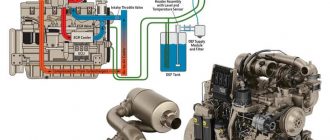
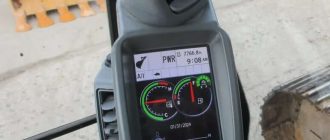
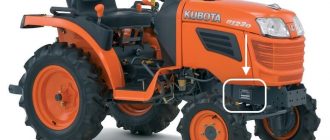
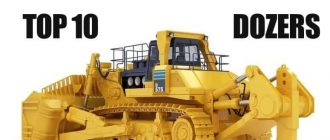
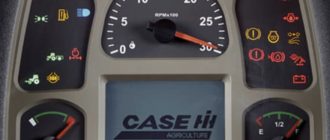

Have a 2019 Kioti CK3510 HST with the following Error code: 283.1 DTC 2 F 05 End 283.1. Temperature was around minus 5 degrees celcius this morning. Block heater on. Installed a brand new battery yesterday. Cannot find the DTC 2 and F05 error codes. Thanks for any help you can give me.
In your case, the number 283.1 on the screen – total run hours
DTC 2 F05 – The Failure Mode Identifier (FMI), which usually indicates a low voltage, open circuit, or an electrical fault in a component.
Possible Causes:
1) Fuel System Issue: A malfunctioning fuel injector / Low fuel pressure or a clogged fuel filter.
2) Electrical Wiring Problem: Loose or damaged wiring harness / Corrosion in connectors or poor ground connection / Poor battery terminal connection.
3) Sensor or ECU Malfunction: Issue with the engine control unit (ECU) / Faulty sensor related to fuel injection or emission control.
Recommended Fixes:
1) Check the fuel system – Ensure fuel injectors are functioning correctly and fuel pressure is normal.
2) Inspect wiring and connectors – Look for broken, loose, or corroded wires in the fuel or electrical system.
Thank you very much for your answers and suggestions. I will check all suggested components. I will keep you posted. Thanks again.
Dashboard will not work or light up gages not working. I checked all fuses in cab. I have a NS 6010 HST a 2024 model. What’s the problem?
If your 2024 Kioti NS6010C HST dashboard is completely dead — no lights, gauges, or indicators — and you’ve already verified that all fuses inside the cab are good, then consider the following most likely causes and what to check next:
1. Main Power Relay or Ignition Relay Failure – Even if fuses are okay, a failed main relay or ignition relay could prevent power from reaching the dash. Check the relays under the hood (often in or near the fuse box or relay panel). You can test a relay by swapping it with another of the same type (like a horn relay).
2. Blown Main Fuse (Outside Cab) – Many tractors have a main power fuse (e.g. 30A, 40A) near the battery or starter solenoid. This fuse may not be in the fuse box inside the cab. Inspect the fuse link or fusible link near the battery terminal or starter — if it’s blown, it would cut power to key systems.
3. Loose or Corroded Ground Connection – A bad ground is a very common culprit for dashboard issues. Check the main chassis ground cable from the battery to the frame — clean and tighten it. Look for any ground straps leading to the instrument cluster or cab.
4. Faulty Ignition Switch – A worn or failed ignition switch may not be sending power to the dash circuits even if it turns over. Check for voltage at the “accessory” and “run” terminals of the ignition switch using a multimeter.
5. Wiring Harness / Connector Problem – Check the harness connector behind or under the dash for corrosion or disconnection. Also check harnesses passing through the firewall — they may have been pulled or pinched.
Optional Step: Test With Multimeter (if you have a multimeter):
– Check for 12V at the dashboard input (usually a red wire).
– Check continuity from the ignition switch to the dashboard.
– Trace power from the battery > main fuse > ignition switch > dash fuse > instrument cluster.